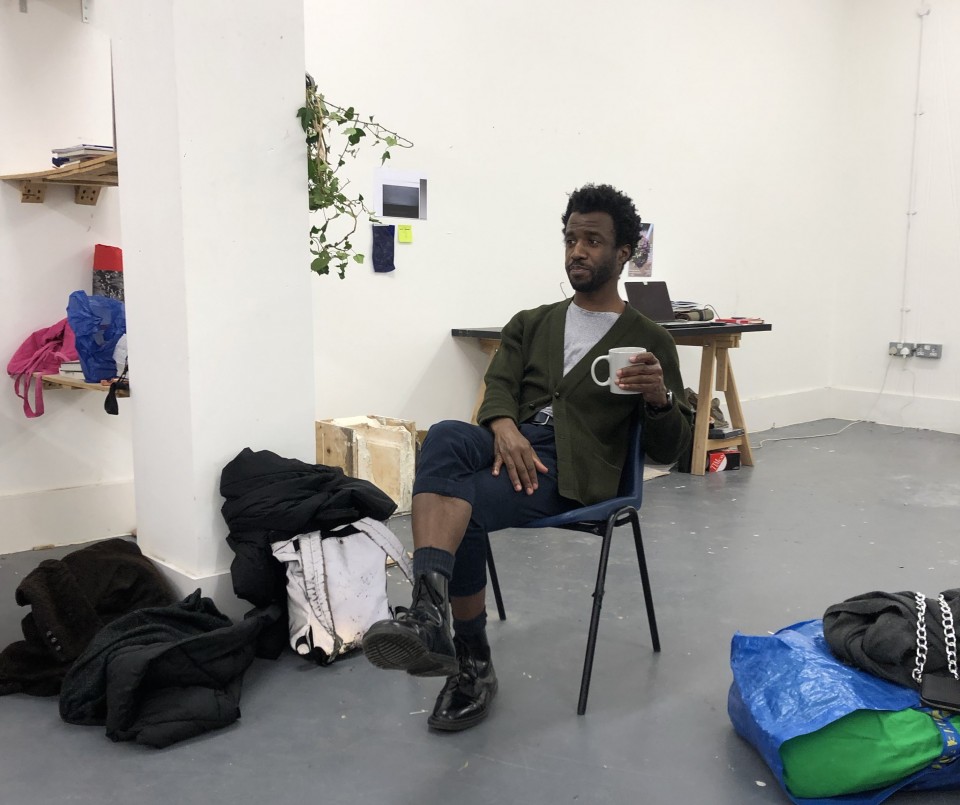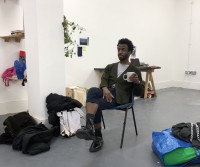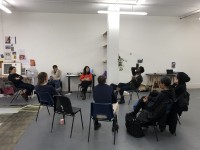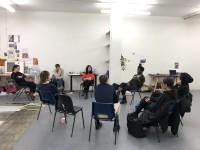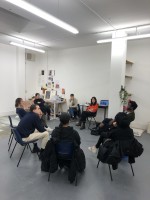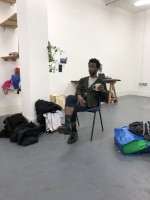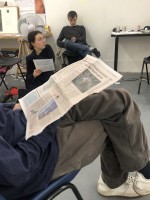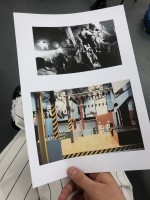After offering Simeon a customary brew of Yorkshire tea, I welcomed a fellow northern native into the studio. I first came across Simeon’s work in the art now room at Tate Modern a few years ago, the artists’ wall bio catching my eye as it mentioned his home town, Huddersfield, which is also my own. Not knowing a contemporary practicing artist from my own locality up until this moment, I was struck by the codes embedded in his mixed-media installation, the stripes of blue and white UV lights pulling on the homebound shirt colours of the Huddersfield football club. Witnessing his layered sculptural structures first hand, I was moved by the immense construction of the frames that help delicate, unstated engravings and scatty, lively video works that activated the industrial plains of wood and steel.
I bumped into Simeon by complete coincidence a few years later whilst I was working in the sculpture park at Frieze art fair. I recognised him from watching his ‘Tate Shots’ video, and I shared a lovely conversation with him over our shared origin and making art in and outside of London. This exchange was recharged into a group discussion at the Associate studios during his visit to the space. Simeon radiated a sincerity towards his attempts, failures and successes in his career, talking openly about rejections of a recent fellowship, his ‘delayed’ start becoming an artist and how his in-depth experience in metal industries has given him an alternative perspective of approach art installations. Simeon brought a newspaper article with him to the studio, which contained imagery of large industrial-scaled machinery, the kind of structures he would build pieces for during his time working before the shift towards creative studies.
Simeon spoke about how he worked on these colossal constructions and really struggled with comprehending the final outcome, but also curious to the meticulous nature of such a process. He mentioned the toxic masculinity that came about in such a work place and its frustrations. However, he also described how he now carriers with him an unconscious connection to the materials and spatial considerations. Despite his initial disregard of his previous profession – as a student actively removing himself from it – he now considers this tie much more positively.
The discussion we had was dynamic and wide ranging and included the issues we face attempting to establish ourselves as an artist, both during and beyond art school. We also spoke about the pros and cons of being in London as artists, compared to other regions of the UK and abroad. A number of the group are from different European cities, some who who have studied abroad and haven’t, those who are from the north and the south, and this provided a rich and at times challenging debate between the best situation for an artist to live and work within.
Simeon also offered another stimulus to the discussion, showing us two images of an infamous nightclub in Manchester, one when it is full of people, enjoying the nightclub atmosphere and crowd, and its often unseen state when the lights come up and no one is left inside. We spoke about the importance of site and architecture in relation to art, with Adelaida Antunez talking about her collaborative project La Cera 13 in Raval/Barcelona. Significance and criticality were brought to the reconstruction and ‘reclamation of site’, especially relating to sites that no longer exist. Discussions of privilege and power in relation to creative collectives nature underpinned this, with Simeon sharing his personal experience of this as a black artist. Participants/Collaborators’ of Adelaida’s recent collaborative work included a number of the Associates, which enabled us to learn more about the extension of this project in the UK and how an ‘art work’ can also operate as a curated platform or as a group exhibition as well as a collaborative work. Lucie MacGregor.
